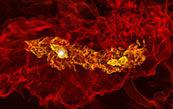- Number 291 |
- July 20, 2009
Simulations illuminate universe's first twin stars

A simulation shows two high-
density
regions, in yellow, about
200 million
years after the Big
Bang. These
regions are
expected
to evolve into
a binary star system.
(Image courtesy of Ralf Kaehler,
Matthew Turk, and Tom Abel,
KIPAC/SLAC.
The earliest stars in the universe formed not only as individuals—as previous research suggested—but sometimes also as twins, according to computer simulations by astrophysicists at the Kavli Institute for Particle Astrophysics and Cosmology, at the DOE's SLAC National Accelerator Laboratory and Stanford University, and at Michigan State University. This work will help researchers fine-tune models for how structure in the universe formed and evolved. It also opens a whole new realm of research opportunities, since if one or both members of such a pair evolved into a black hole, it could release gravitational waves or gamma-ray bursts-phenomena of great interest to the astrophysics community.
[Melinda Lee, 650.926.8547,
melinda.lee@slac.stanford.edu]
